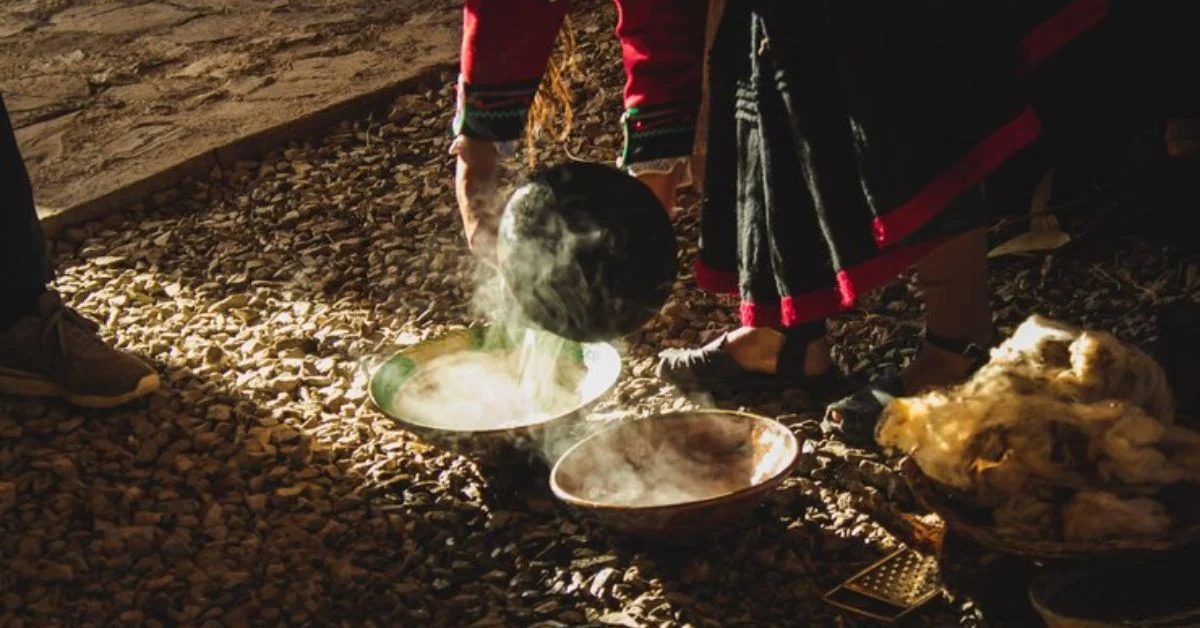In the highlands of the Amazon basin, long before the age of global commerce or Western wellness trends, indigenous tribes used a powerful tool for healing, meditation, and connection with nature—tépi. This ceremonial pipe is central to the sacred use of rapé (pronounced ha-PAY), a finely ground herbal snuff with both medicinal and spiritual applications. Unlike modern wellness fads, tépi represents a millennia-old tradition deeply intertwined with ancestral wisdom.
What is Tépi?
Tépi is a traditional ceremonial pipe used by indigenous tribes—particularly the Yawanawá, Huni Kuin, and Kaxinawá—of the Amazon rainforest to administer rapé, a sacred snuff made from various medicinal plants, primarily powdered tobacco and other ashes or herbs. The pipe typically has two ends: one inserted into the nostril of the receiver, and the other blown into by a practitioner or shaman.
While rapé can also be self-administered using a kuripe (a V-shaped pipe), the tépi involves another person blowing the snuff into the recipient’s nostrils, often in a ritual setting. This shared administration is not just practical—it carries a strong spiritual symbolism of guidance, cleansing, and shared energy.
Historical and Cultural Origins
The roots of tépi stretch back thousands of years, embedded in the rich oral traditions and ceremonial practices of Amazonian tribes. The word itself is believed to derive from tribal dialects in Brazil and Peru, though spellings and pronunciations vary by region.
This was never used casually. In its origins, it was administered by tribal healers and shamans during rituals of initiation, purification, and spiritual alignment. These rituals were often held in sacred groves or communal huts, accompanied by chanting, singing, and other plant medicines like ayahuasca. This was—and remains—a vessel of power. It’s a conduit for connecting human consciousness with the natural and ancestral realms.
Anatomy of a Tépi Pipe
Tépi pipes are handmade and vary greatly depending on the artisan and tribe. However, a few core elements remain consistent:
- Material: Typically made from bamboo, bone, or carved wood. Some include decorations of feathers, beads, or snake skin to invoke spiritual protection or tribal identity.
- Design: Usually a straight or slightly curved tube about 12–18 inches long, with one end shaped to fit the nostril.
- Symbolism: Carvings may include tribal sigils, animal spirits, or geometric shapes representing the cosmos or Earth spirits.
The making of a tépi pipe is in itself a ritual. Elders may pass down techniques for carving, blessing, and charging the pipe with intention. This ensures the tépi isn’t just an object—it becomes a spiritual tool.
Rapé and Tépi: A Symbiotic Pair
Rapé is inseparable from tépi. The fine, dry powder is made from a combination of tobacco (Nicotiana rustica) and alkaline ashes from burned medicinal trees and herbs like Tsunu or Murici. It’s blended over weeks, with careful rituals to honor the plants’ spirits.
When delivered through the tépi, the rapé powder is blown sharply into each nostril. This is not a subtle experience. The blow is intentional and forceful, symbolizing the penetration of spiritual energy, the dislodging of psychic debris, and the anchoring of one’s spirit into the present moment.
Why Tépi is Preferred Over Kuripe in Ceremonies
- Connection: Tépi represents the sacred bond between giver and receiver.
- Precision: A trained practitioner can control the force and dosage better.
- Spiritual Transmission: The energy of the one administering the rapé is believed to travel through the pipe, enhancing the effect.
Uses and Benefits of Tépi Administration
While modern interest in rapé has spiked for its perceived benefits—clarity, focus, detoxification—the traditional uses of téepi extend far beyond the physical.
Spiritual Benefits
- Energetic Cleansing: Téepi-administered rapé is often used to remove stagnant energy or emotional blockages.
- Grounding: Many report feeling immediately anchored and present after receiving.
- Heightened Awareness: Some use it before meditation or ceremony to enter a deeper state of awareness.
Psychological and Emotional Healing
- Users often experience emotional releases, including crying or intense introspection.
- It can assist in reframing negative thought patterns and bring clarity to inner conflicts.
Physical Health Support
Although scientific studies are limited, indigenous peoples report benefits such as:
- Sinus clearing
- Headache relief
- Improved focus and wakefulness
Modern Relevance and Global Expansion
In recent decades, tépi and rapé have moved beyond Amazonian borders, embraced by Western spiritual seekers, wellness practitioners, and psychedelic explorers. However, this global adoption raises important questions about cultural appropriation, sustainability, and ethical sourcing.
Global Interest
- Ayahuasca Retreats: Téepi is often part of pre-ceremony rituals.
- Neo-Shamanic Workshops: Rapé circles have become common across Europe and North America.
- Spiritual Coaching: Some holistic coaches incorporate téepi-administered rapé into breathwork or trauma release sessions.
Ethical Considerations
- Cultural Respect: Using teépi should not be done casually or recreationally.
- Sourcing Issues: Sustainable and fair-trade rapé blends and pipes are essential to avoid harming the tribes that developed them.
- Spiritual Readiness: Receiving rapé via téepi should involve inner preparation and clear intention—not curiosity or peer pressure.
The Tépi Ceremony: What to Expect
Participating in a téepi ceremony can be a profound experience. Here’s what typically happens:
- Opening Prayer or Chant: Invokes the spirit of the plants and the tribe’s ancestors.
- Blowing of Rapé: Administered one nostril at a time. The first blow often catches the person off guard.
- Moment of Stillness: Recipients sit quietly, allowing the medicine to work.
- Emotional or Physical Release: Sneezing, crying, or shaking may occur—these are normal.
- Closing Words or Song: Ends the ritual, giving thanks to the medicine.
Potential Risks and Misuse
Despite its sacred nature, tépi should not be treated as a panacea or a trend.
- Not for Everyone: Those with respiratory issues or psychiatric conditions should avoid it.
- Misadministration Risks: Incorrect blow strength or impure rapé can cause physical harm.
- Lack of Context: Using tépi without understanding its cultural roots diminishes its power and intent.
Tépi in the Digital Age: Spirituality Meets Technology
A curious modern phenomenon is the online sale of teépi pipes—handmade versions sold through artisan sites, spiritual marketplaces, and social media. While this democratizes access, it also risks commodifying a sacred item.
To honor tépi’s tradition:
- Buy from verified indigenous makers.
- Engage in education before practice.
- Understand that the pipe is a bridge, not a shortcut.
Conclusion
Tépi is far more than a hollow pipe used to deliver herbal snuff. It is a sacred conduit, a vessel of ancestral memory, and a tool for transformation. Rooted in the rainforest but now echoing across global spiritual landscapes, it invites us into a deeper relationship with ourselves, nature, and the unseen.
Its rise in global consciousness presents both opportunity and responsibility. Those who choose to work with tépi must do so with respect, intention, and a willingness to listen to the wisdom of its origin keepers. In doing so, it becomes not just a ritual tool, but a reminder: that healing, when done in community and with reverence, has the power to cross continents and cultures.
Frequently Asked Questions (FAQs)
1. What is the difference between a teépi and a kuripe?
A tépi is used by another person to administer rapé during a ceremony, while a kuripe is a V-shaped pipe used for self-application. Téepi is favored in ritual settings due to its symbolic and energetic significance.
2. Is using tépi safe for beginners?
Tépi use is best experienced under the guidance of someone trained in the tradition. Beginners should not attempt to use or receive rapé via tépi without understanding its physical and energetic effects.
3. Can I buy a tépi online?
Yes, but be cautious. Always source from indigenous artisans or trusted spiritual suppliers to ensure the pipe is made respectfully and sustainably.
4. Does tépi use involve any psychoactive substances?
Rapé, the substance used with tépi, typically contains Nicotiana rustica, which has high nicotine content. It is not hallucinogenic, but it is powerful and can induce intense physical and emotional reactions.
5. How often can tépi-administered rapé be used?
Traditional use varies by tribe, but generally, it is not intended for daily use. Weekly or bi-weekly use is common, with the emphasis on intention and purpose, not frequency.
For more information, click here.









